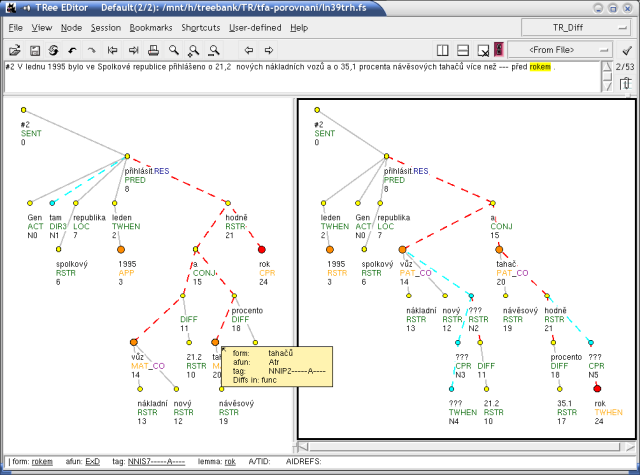TrEd is a fully customizable and programmable graphical editor and viewer of tree-like structures such as dependency trees. Among other projects, it was used as the main annotation tool for syntactical and tectogrammatical annotations of The Prague Dependency Treebank, as well as for decision-tree based morphological annotation of The Prague Arabic Dependency Treebank.
TrEd's default behavior can be customized (extended or narrowed) using so called annotation modes (previously called binding contexts) that can provide different interfaces for different types of data or annotation. An annotation mode usually consists of a set of macros (subroutines programmed in Perl) that can be bound to keyboard shortcuts, menus, toolbars, or certain automatically triggered events. TrEd comes with an extensive library of pre-defined macros, which greatly simplifies writing new annotation modes.
The visual representation of trees in TrEd can be customized independently on the annotation mode by user-defined stylesheets.
TrEd supports various input and output formats. Some of them are of general nature (e.g. a XML-based format called PML or a simple text-based format called FS-format developed by Michal Kren), while other are bound to a particular project. Support for new formats can be added by writing a custom I/O _backend (a Perl module able to convert data from their format-specific representation into the internal representation used by TrEd, and save them back in the original format) or by providing a pair of XSLT (1.0) stylesheets that convert a given XML-based format to PML and back.
Annotation modes, libraries of macros, styles, I/O transformations, resources (such as dictionaries, PML schemas, etc.), example data, etc. can be easily distributed to TrEd users as so called Extension Packages that are easy to create, deploy, install, and update.
There is also a non-graphical (off-line) variant of TrEd, usefull for batch processing of tree-like data. It is called btred — “Batch-mode Tree Editor” and allows users to apply TrEd macros on trees without having to enter the graphical interface. This tool is further acompanied by another tool, named ntred. NTrEd allows for parallelizing btred processing over a cluster of networked machines. In combination with TrEd, it can also be used as an extremely powerful search engine over large base of data.
Figure 1. TrEd's main window with two views highly customized for visual comparison of trees of the Prague Dependency Treebank project.

TrEd runs on the following platforms (see Section 2, “Installation and start up instructions” for details):
Windows 2000/XP/Vista™
Linux™
MacOS X™ (X11), BSD™, UNIX™, Solaris™ and other UNIX-based systems
Pajas Petr, Stepanek Jan: Recent Advances in a Feature-Rich Framework for Treebank Annotation. In: The 22nd International Conference on Computational Linguistics - Proceedings of the Conference, The Coling 2008 Organizing Committee, Manchester, UK, ISBN 978-1-905593-45-3, pp. 673-680, 2008.